The 2004 Sea Doo RXP
My review (I own 2 of them)
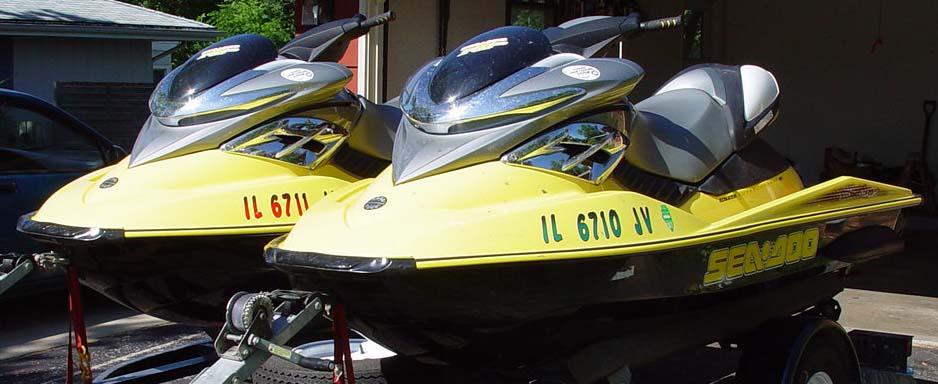
My interest in Personal watercraft has spanned a decade now. My wife and I bought our first 1994 Sea Doo SP, and things have never been the same. Our poor Boat now is a trailer queen, and never gets much use any more. This year in 2004 Sea Doo released the next generation of personal watercraft, the RXP. These are the most impressive of all of the watercraft I have owned, so I thought I would do a quick review of this machine for anybody who may be interested.
For reference I have owned the following watercraft:
1994 Sea Doo SP
( Our first, top speed about 33 MPH, and when fitted with a stainless steel impeller maybe 38MPH) This craft ran perfectly, never an issue
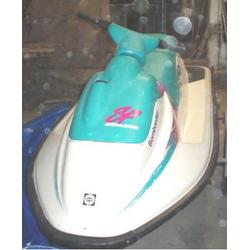
1995 Sea Doo XP
(The second, to ride along with the SP this one blew the engine in the second year, and I had it rebuilt by Rossier Engineering top speed possibly 49 MPH)
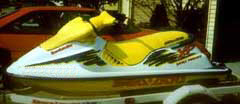
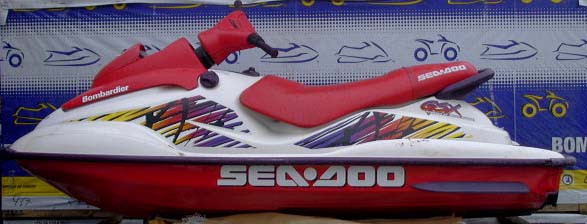
1998 Sea Doo GSX Ltd.
A great craft, This one was only modified to remove the faulty air box that would ingest a small amount of water, and cause a blown engine. I added a Rossier engineering jet kit, flame arrestors, and flame arrestor outer covers. This made the top speed around 64MPH when my wife drove it around 63MPH when my fat body was on it. The only problem with this craft was the vibration that caused the bolts holding the exhaust pipe in place to shear and snap. It must have been quite severe, as both times they were 10mm stainless steel bolts. A mod kit came out in 2000 that put a rubber jacket around the joint from the exhaust port on the engine to the pipe. The kit also had reduced shoulder studs that allowed a small amount of slip and alignment of the pipe to the lower bolt's that held it in place to the engine. Once installed this only put more stress on the lower bolts which eventfully snapped. I reworked the lower pipe section by installing a stainless helicoil. I couldn't believe that Bombardier would run a bolt directly into an aluminum casting, but that was the case. In any event, I reworked all threaded holes in the exhaust pipe with Stainless helicoils. The broken stud was particularly difficult to remove, as they used the Hi temp yellow loctite on these broken studs. Never use EZ outs on broken studs. Instead find a hex wrench that is mounted to a socket drive. It should be 1/2 the size of the stud to remove, drill the center of the stud so the hex will broach the hole when beaten into stud. With an acetylene torch, carefully heat the drilled hole until red, quickly beat the hex into the drilled hole, and allow to cool you should be able to back the broken stud out.
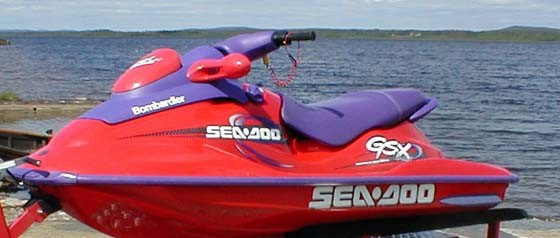
A pair of 2001 Sea Doo RX's
after all of the fussing with prior watercraft, I wanted to only keep a watercraft that was only a few years old, so we opted for these. They added reverse to these, extended the hull length around 12 inches, changed the hull design, made the sponsons with a deeper cut, and added some extra weight. At first I objected to the new hull length, and the reverse feature, but after a few hours of riding, I changed my mind. The new hull design made moderately rough water riding, much easier, I was not sore the next day, and the reverse was a real handy feature. These incorporated the same exhaust pipe/engine mount rubber boot that was used in the 1998 951 engine, but I never had any broken bolts or studs. These remained stock for the duration. Top speed on these was around 63MPH. but comfortable. These were both carburated, At the time Bombardier was experimenting with both direct inject, and orbital fuel injection. With the debacle's of the 1997 GSX Ltd, and the blow outs, I did not want to participate in the problem development and finding process.
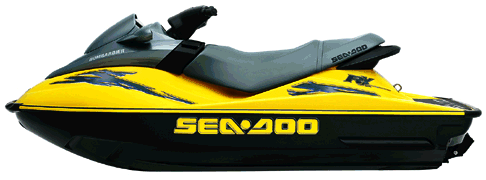
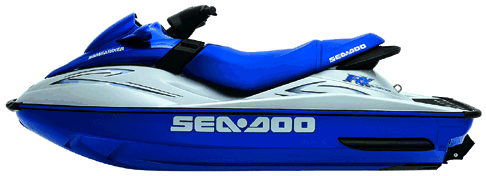
Well this year, 2004 we opted for a pair of the new RXP's
Here is our opinion and review
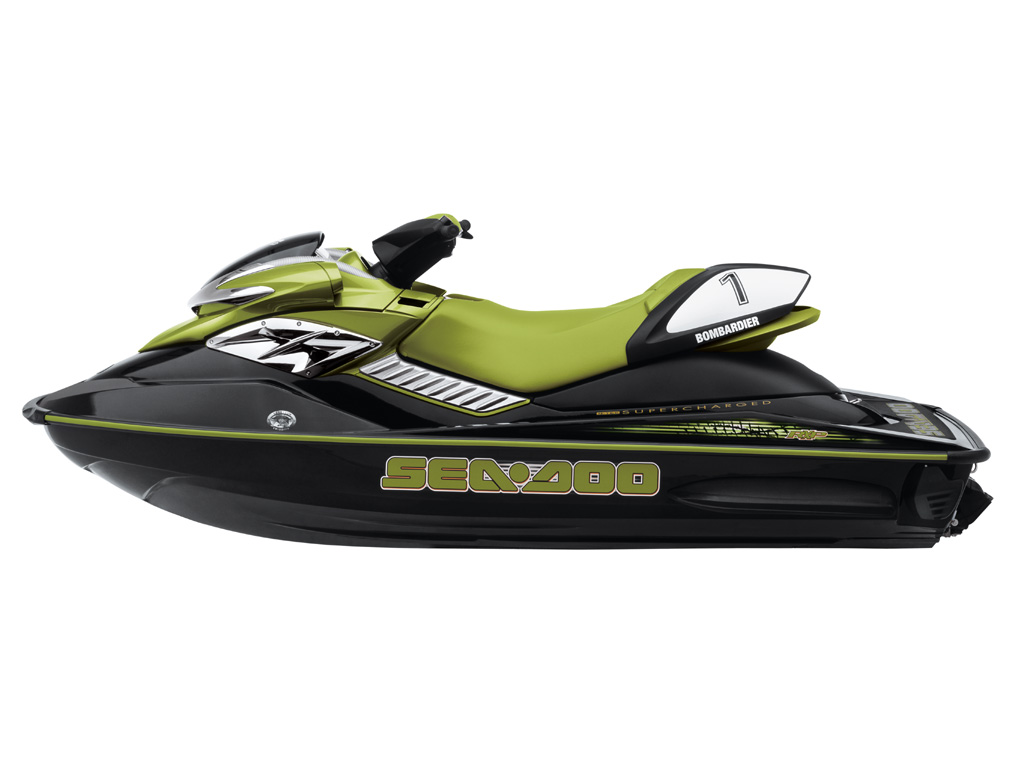
First issue, The Weight 790 Lbs up from the 550 or so the RX's were, so I had to beef up the trailer, or buy a new one. Last year, I had spent a weekend rebuilding double bunks on this trailer. The new trailers all used the same single 2x4 bunks that I originally had, so I was not interested in this effort, again. I had also years earlier replaced the cheap broken plastic fenders with new steel types, and the axle spring setup on this trailer was rated at 2500 Lbs, lets just upgrade the wheels and tires for the new weight rating cost was $65 each wheel, plus one spare. And again this year the hull became another 10 inches longer. The dealer told me that the new engine was breaking the original RX hull, so they had to use the 3 seat GTX frame.
WEIGHT Rating 6 out of 10
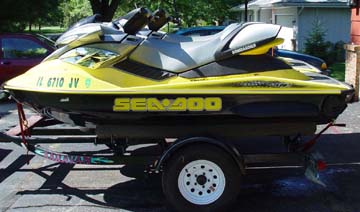
I did not much care for the new hood style, looks like it adds to the weight problem, and the scoops are non functional. I guess after a few months it has grown on me
STYLE: Rating 7 out of 10
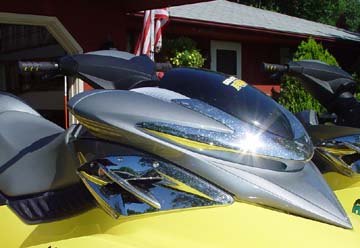
Here is what's under the fake scoops, the fuel fill, now more difficult to get at. The extra space can be used to lay things in when you are adrift, or just puttering around, like a radio. There is no longer a fuel shutoff, reserve petcock now
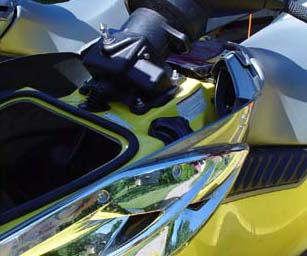
The biggest improvement gained from the extra hull size so far, the battery has been increased in size, and move to a much easier accessible location, the front stowage compartment. Now you no longer have to stand on your head to get the battery out when it's time to winterize.
BATTERY LOCATION Rating 8 out of 10

This is what it is all about, the 215 HP 1500 cc supercharged 4 stroke engine. This makes the 800lbs of craft a monster.
The throttle response is instantaneous, from a dead standstill with full up trim, this baby will leap straight out of the water by about a foot. It literally caught me off guard the first time, nearly throwing me from the craft.
ENGINE PERFORMANCE Rating 10 out of 10
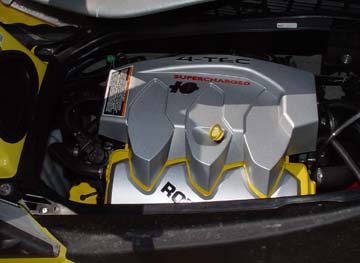
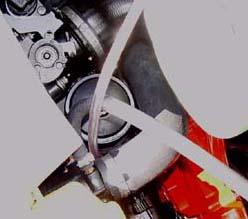
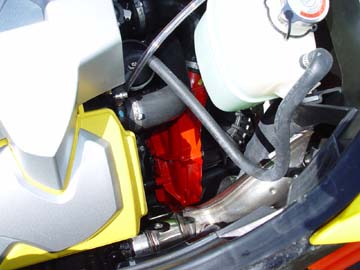
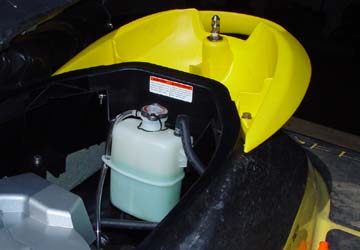
And this is where the engine heat gets out. The ride shoe has an internal radiator, or heat exchanger molded into the casting. This keeps the engine just as cool as the water your in, but spares running all of the contaminates through the engine itself, great idea. I'm just a little concerned as to how tough this is, and if there is a chance of scratching through, or ruining it though
COOLING SYSTEM Rating: 9 out of 10
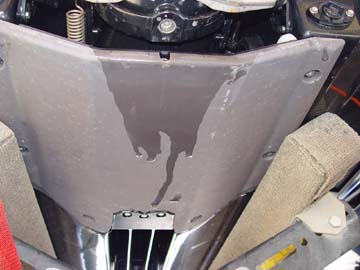
The OPAS system, Or Off Power Assisted Steering. The manual claims that when under 70 % throttle setting that these are supposed to drop down lower and help steer the craft. What are the odds, but these don't work on either of the 2 new craft. I think it's probably to complicated of a solution to the problem. This is unnecessary extra claptrap, and a lousy idea
OPAS Rating 2 out of 10
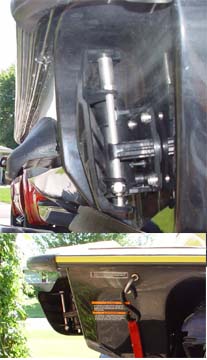
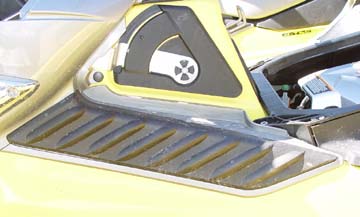
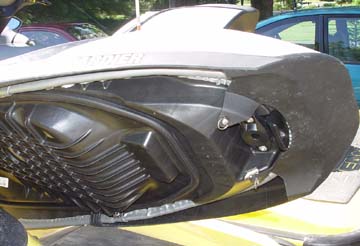

Another improvement this year, a nice big START/STOP button that can be easily worked. The old recessed rubber buttons were sometimes tough to operate. These big buttons are a lot nicer, and easy to use
OPERATOR CONTROLS Rating 7 out of 10

Fuel performance.
As of this writing we have put almost 1000 miles on these craft. We have spent a lot of time on pool #13 at the Mississippi river that about 30 miles from lock #12 to lock #13. The fuel mileage is an average of the two craft over several trips but this is what you can expect.
| Idling 4 MPH | 1800 RPM | I don't know, cant stand to do it for long! |
| up on plane 20 MPH | 4000 RPM | 7.5 - 8 MPG |
| 30 MPH | 4700 RPM | 6.5 - 7 MPG |
| 45 MPH | 5500 RPM | 5.5 MPG |
| 55 MPH | 6500 RPM | 4.5 MPG |
| 65 MPH | 7400 RPM | 3.5 MPG |
| WOT 68 MPH | 7850 RPM | 2 MPG |
Other Items of interest
I tried to reuse my DESS lanyards from the earlier watercraft, and they always worked. When they put them on these, they were intermittent, to almost not working at all. I took them back to the dealer, and asked him to look at it. After a day, of reprogramming both craft, they said they talked to the Sea Doo support, and were told that this was to be expected, there was no fix. The charge to get a new key was $25, and another $25 for the programming fee. This is a pisser, if I had know about this issue, I would have bought 2 extra keys up front. These craft have learning keys that cut the speed back to I guess 30 MPH. It's my guess that any craft that uses learning keys, will have the issue with the earlier DESS keys. I sold my other two keys on Ebay, and put this disclaimer with them. I would not recommend trying to buy any DESS used keys on the aftermarket for any new watercraft with the learning key function for quite some time. Shame on Sea Doo !!!
What needs improvement
With the bigger battery, some type of cigarette lighter somewhere ! I have on these and prior watercraft installed one with a 10 A fuse in line on the end of a cord. It's nice to have for minor things like cell phones, and other entertainment devices.
How about an AM/FM radio with a jack for an MP3 player. I'm not talking about a 600 watt system here. I have to pack a small pocket FM stereo, and a set of small waterproof speakers. With all of the extra room in the hood and cowl it should not be a big deal to put in a small radio and speakers. It could be sized such that it is not a big drain on the battery.
A depth finder feature on the INFO display. It has been and is a constant challenge to know what conditions are when approaching shore, or just riding around. The extra $100 or so would be worth the cost of a rock going through the jet pump
Fix those damn rubber pads used as foot rests, and back deck pad. Every freshman materials engineer knows that the coefficient of expansion of black rubber and fiberglass in hot sun is vastly different. I'm tired of this stuff swelling up when its hot, and allowing sand and small gravel to work its way under, and further aggravating the problem. It's impossible to clean ! Besides, It does not offer anything in the means of padding to protect your knees whae reboarding out in open water.